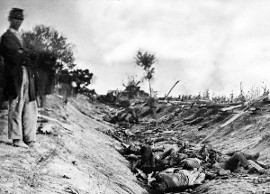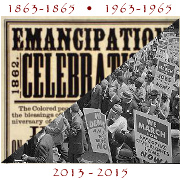The Emancipation Proclamation: “… all the moral grandeur of a bill of lading”
Posted September 17th, 2012 by Katrina BrowneCategory: Public History Tags: Abraham Lincoln, Battle of Antietam, Battle of Sharpsburg, Emancipation Proclamation, Sesquicentennial of the U.S. Civil War
 A week ago I was still pronouncing “Antietam” as if it rhymed with “Vietnam.” Now I know it’s pronounced “Anteetum” … and so much more. My husband John and I had heard about the 150th anniversary commemorations of the Battle of Antietam/Battle of Sharpsburg, and since we’d been meaning to have a camping get-away, we decided that this was a great excuse to get outdoors and pursue my work goal of seeing how the 150th of the Civil War, and the role of slavery in the war’s causes and consequences, is being acknowledged at battlefields.
A week ago I was still pronouncing “Antietam” as if it rhymed with “Vietnam.” Now I know it’s pronounced “Anteetum” … and so much more. My husband John and I had heard about the 150th anniversary commemorations of the Battle of Antietam/Battle of Sharpsburg, and since we’d been meaning to have a camping get-away, we decided that this was a great excuse to get outdoors and pursue my work goal of seeing how the 150th of the Civil War, and the role of slavery in the war’s causes and consequences, is being acknowledged at battlefields.
Wow.
The Antietam National Battlefield is run by the National Park Service, and is one of the most preserved Civil War battle sites in the nation, so it looks much as it did prior to the battle; development has been held at bay. The beautiful rolling fields, the Dunker Church, the Mumma Farm are still there. But so too is “Bloody Lane,” the sunken road that symbolizes the fact that 150 years ago today was the bloodiest in American history: there were 23,000 combined deaths and injuries. You can imagine it, and you can’t. So many cannon and other arms were being fired that there was thick black smoke hanging in the air, reducing visibility and adding to the hell of it. It was here that the federal government began assuming more powers than before: that of identifying and burying the dead. (Tomorrow evening PBS will air Ric Burns’ documentary based on Harvard University President Drew Faust’s book: This Republic of Suffering on the Civil War dead.)
The National Park Service organized three powerful days of educational and reverential events. This included talks by renowned historians, such as Dr. Faust. It won’t surprise anyone who knows my work, and the Tracing Center’s work, that I was on the lookout for myth-busting information—with regard to the North’s self-righteousness (“we’re the good guys who went South to free the slaves”), and the South’s deflections (“we didn’t fight for slavery, we fought for states’ rights”).
Indeed, myths were busted.
PART I: North first (that’s my deal: tell on yourself first)
As I learned from academic historians and park rangers, part of the significance of the Battle of Antietam is that because it was a strategic victory for the Union, it gave Lincoln the opportunity to issue the preliminary Emancipation Proclamation five days later, on September 22, 1862. He had drafted the Proclamation and shared it with his cabinet back in July, but his Secretary of State, William Seward, had advised that it would be a sign of weakness to issue it when the Union had been suffering so many defeats in battle. Better to wait until there was a victory, and from a position of strength issue the Proclamation. Fundamental to this logic was the idea that emancipation would serve as a military measure in the Confederate states—freed slaves would be invited to join the Union Army and help put down the rebellion—but that it should not appear to be a desperate measure. Those enslaved in the North, in the border states, and in the Union-occupied areas of the Confederacy were not in fact freed by the Proclamation. The London Times wrote at the time, “Where he has no power Mr. Lincoln will set the negroes free; where he retains power he will consider them as slaves.” What kind of freedom was this?
For those of us who, like myself, retained only a simple middle-school version of much of American history, the Emancipation Proclamation survives in our imagination as a glorious document, leading to one of the most exalted moments in American history: the ending of slavery. When you get into the messy details, you learn, as was summed up in 1948 by historian Richard Hofstadter (and quoted by historian Mark Neely this weekend), “The Emancipation Proclamation of January 1, 1863, had all the moral grandeur of a bill of lading.” In its language, the timing and strategy surrounding its issuance, and in its effect, it was a more muted victory for black Americans than we white Northerners, and white Americans more broadly, like to self-congratulatorily assume. This is not to take away from the complex and exceedingly challenging circumstances within which President Lincoln had to maneuver—militarily, politically and morally. But it is to say that we who consider ourselves to be his heirs should not presume too hastily to dress in cloaks of moral superiority. Part of Abraham Lincoln’s calculations, and public relations tactics, were in fact designed precisely to deal with the fact that a considerable portion of Northern public opinion was NOT in favor of ending Southern slavery, much less risking life and limb for that cause.
For the South’s turn for having myths busted, stay tuned for PART II.



Leave a Reply